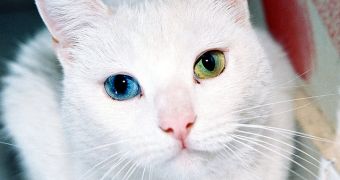Heterochromia is a difference in coloration among irises, making your pets have one green and one blue eye, for example. It can also manifest itself by a portion of the iris differing in color from the rest. The latter is referred to as sectoral heterochromia.
The iris is a circular structure in the eye, consisting of one front pigmented tissue or stroma, and underlying epithelial cells. The iris is responsible for the amount of light reaching the retina, Wikipedia informs.
Heterochromia occurs when melanin – the pigment that makes eyes the color we perceive them as having – is not distributed and concentrated in the same amounts among the irises.
Melanin is not only responsible for the color of your eyes, but also determines skin and hair color. In humans, different ethnic groups are genetically programed to their bodies producing less or more melanin, which is what causes differences in the color of our skins.
According to ArkinSpace, the Turkish Van cat and the Angora are the cat breeds most commonly affected by heterochromia. These cats are usually white, an indicator of the fact that melanin is produced in very small amounts, and tend to have one eye lacking in coloration. Said affected eye is usually blue.
In the case of dogs, the husky usually displays the odd iris coloring, but Australian Shepherds and Catahoula Leopard dogs are also prone to developing the condition. Heterochromia has been recorded in horses, especially pinto colored, cattle, as well as buffalo.
Heterochromia can be genetic or acquired. Irises are darker or lighter either due to genetic factors, or to a disease, syndrome or injury. If the difference in coloration is congenital, your pet is most likely safe and the colors of its eyes resulted from a genetic abnormality.
Mosaicism, in which different genotypes arise from a single fertilized egg cell and are developed in one individual, is most likely the underlying factor, causing your pet's body to basically go crazy and start producing varying amounts of melanin.
If your pet suffers from heterochromia, there is a possibility of a tumor having affected its pineal gland that produces melanin. It can also occur after an injury or inflammation, in which case eye color would change during your pet's lifetime. The use of eyedrops has also been linked to iris discoloration.

 14 DAY TRIAL //
14 DAY TRIAL //